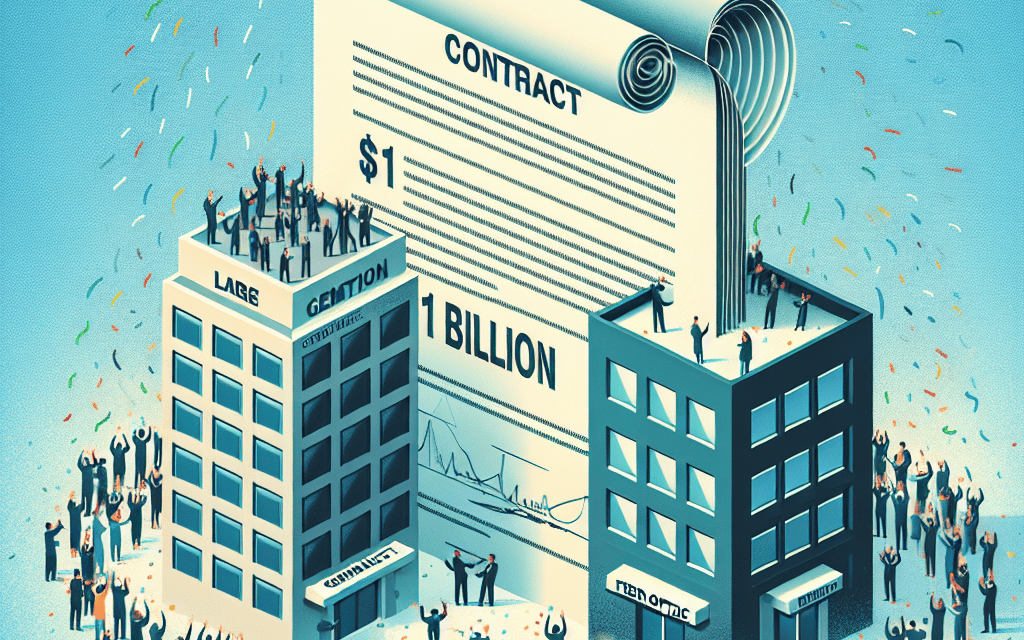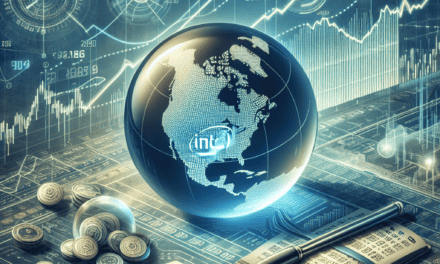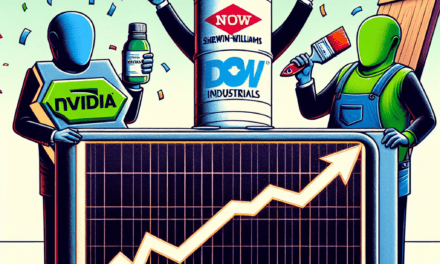“Connecting the Future: AT&T and Corning’s $1 Billion Fiber Partnership”
Introduction
AT&T has announced a significant $1 billion agreement with Corning Incorporated to enhance its fiber optic network infrastructure. This strategic partnership aims to bolster AT&T’s capacity to meet the growing demand for high-speed internet services by expanding its fiber footprint across the United States. The collaboration with Corning, a leading innovator in materials science and fiber optic technology, underscores AT&T’s commitment to advancing its network capabilities and delivering faster, more reliable connectivity to its customers. This investment is part of AT&T’s broader strategy to accelerate its fiber deployment and support the increasing need for robust digital communication solutions in both urban and rural areas.
Impact Of AT&T’s $1 Billion Fiber Agreement On The Telecommunications Industry
AT&T’s recent announcement of a $1 billion fiber agreement with Corning marks a significant development in the telecommunications industry, promising to reshape the landscape of internet connectivity in the United States. This strategic partnership is poised to accelerate the deployment of fiber-optic infrastructure, a critical component in meeting the ever-growing demand for high-speed internet access. As the digital age continues to evolve, the need for robust and reliable internet connections has become paramount, and this agreement underscores AT&T’s commitment to addressing this demand.
The collaboration between AT&T and Corning is expected to have far-reaching implications for the telecommunications sector. By investing in fiber-optic technology, AT&T aims to enhance its network capabilities, thereby providing faster and more reliable internet services to its customers. This move is particularly significant as it aligns with the broader industry trend of transitioning from traditional copper-based networks to fiber-optic systems, which offer superior performance in terms of speed and bandwidth. Consequently, this agreement is likely to set a precedent for other telecommunications companies, encouraging them to invest in similar infrastructure upgrades to remain competitive.
Moreover, the $1 billion investment is anticipated to stimulate economic growth by creating job opportunities within the fiber-optic manufacturing and installation sectors. Corning, a leading manufacturer of fiber-optic cables, will play a crucial role in this endeavor by supplying the necessary materials to support AT&T’s expansion plans. This partnership is expected to generate thousands of jobs, not only within Corning’s manufacturing facilities but also in the broader telecommunications industry, as skilled workers will be needed to install and maintain the new infrastructure. This economic boost is particularly timely, given the ongoing challenges posed by the global pandemic, which has underscored the importance of reliable internet access for remote work and education.
In addition to its economic impact, the agreement is likely to have significant social implications. By expanding its fiber-optic network, AT&T aims to bridge the digital divide, ensuring that underserved and rural communities have access to high-speed internet. This is a critical step towards achieving digital equity, as it enables individuals in these areas to participate fully in the digital economy, access educational resources, and benefit from telehealth services. The enhanced connectivity will also support the proliferation of smart technologies and the Internet of Things (IoT), further integrating digital solutions into everyday life.
Furthermore, the partnership between AT&T and Corning highlights the importance of collaboration in driving technological advancements. By leveraging Corning’s expertise in fiber-optic technology, AT&T can accelerate its network expansion efforts, ultimately benefiting consumers through improved service quality. This collaboration serves as a model for other companies in the telecommunications industry, demonstrating the value of strategic partnerships in achieving shared goals.
In conclusion, AT&T’s $1 billion fiber agreement with Corning represents a pivotal moment in the telecommunications industry, with the potential to transform internet connectivity across the United States. By investing in fiber-optic infrastructure, AT&T is not only enhancing its network capabilities but also contributing to economic growth and social progress. As the industry continues to evolve, this agreement sets a benchmark for future investments in technology and infrastructure, underscoring the critical role of collaboration in driving innovation and meeting the demands of the digital age.
How Corning’s Partnership With AT&T Will Enhance Fiber Optic Infrastructure
AT&T’s recent announcement of a $1 billion fiber agreement with Corning marks a significant milestone in the enhancement of fiber optic infrastructure across the United States. This strategic partnership is poised to address the growing demand for high-speed internet connectivity, which has become increasingly critical in today’s digital age. As the world becomes more interconnected, the need for robust and reliable internet infrastructure is paramount, and this collaboration between AT&T and Corning is set to play a pivotal role in meeting these demands.
The agreement between AT&T and Corning is not merely a business transaction; it represents a concerted effort to expand and improve the nation’s fiber optic network. Fiber optics, known for their ability to transmit data at the speed of light, are essential for delivering high-speed internet services. This technology is crucial for supporting a wide range of applications, from streaming services and online gaming to telecommuting and telemedicine. By investing in fiber optic infrastructure, AT&T aims to enhance the quality and reliability of its services, thereby providing customers with a superior internet experience.
Corning, a leader in materials science and a pioneer in fiber optic technology, is well-positioned to support AT&T’s ambitious goals. With decades of experience in the development and manufacturing of optical fiber, Corning brings a wealth of expertise to the table. The company’s innovative solutions and commitment to quality make it an ideal partner for AT&T as it seeks to expand its fiber network. Through this partnership, Corning will supply AT&T with the necessary fiber optic cables and related components, ensuring that the infrastructure is built to the highest standards.
Moreover, this collaboration is expected to have a positive impact on the broader telecommunications industry. As AT&T and Corning work together to enhance fiber optic infrastructure, other companies may be encouraged to follow suit, leading to increased investment in this critical area. This could result in a more competitive market, ultimately benefiting consumers through improved services and potentially lower prices. Additionally, the expansion of fiber optic networks can stimulate economic growth by creating jobs in manufacturing, installation, and maintenance.
Furthermore, the partnership between AT&T and Corning aligns with broader national objectives to improve internet access and bridge the digital divide. In many rural and underserved areas, access to high-speed internet remains limited, hindering economic development and educational opportunities. By expanding fiber optic infrastructure, AT&T and Corning can help bring high-speed internet to these communities, fostering greater inclusivity and enabling individuals and businesses to thrive in the digital economy.
In conclusion, the $1 billion fiber agreement between AT&T and Corning represents a significant step forward in the enhancement of fiber optic infrastructure in the United States. This partnership not only underscores the importance of investing in high-speed internet connectivity but also highlights the potential for collaboration between industry leaders to drive innovation and progress. As AT&T and Corning work together to build a more robust and reliable fiber network, they are paving the way for a more connected and prosperous future. Through their efforts, they are not only meeting the demands of today’s digital landscape but also laying the groundwork for the technological advancements of tomorrow.
The Economic Implications Of AT&T’s Investment In Fiber Optics
AT&T’s recent announcement of a $1 billion fiber agreement with Corning marks a significant milestone in the telecommunications industry, with far-reaching economic implications. This strategic investment underscores AT&T’s commitment to expanding its fiber optic network, a move that is poised to enhance connectivity and drive economic growth. As the demand for high-speed internet continues to surge, the deployment of fiber optics is becoming increasingly crucial. Fiber optics offer superior speed and reliability compared to traditional copper cables, making them an essential component of modern telecommunications infrastructure. By partnering with Corning, a leader in materials science and fiber optic technology, AT&T is positioning itself to meet the growing needs of consumers and businesses alike.
The economic implications of this investment are multifaceted. Firstly, the expansion of fiber optic networks is expected to create a substantial number of jobs. The construction and maintenance of these networks require skilled labor, which will likely lead to job creation in various sectors, including engineering, construction, and technology. This, in turn, can stimulate local economies, as increased employment leads to higher consumer spending and economic activity. Moreover, the enhanced connectivity provided by fiber optics can have a transformative impact on businesses. High-speed internet is a critical enabler of innovation and productivity, allowing companies to operate more efficiently and compete in the global marketplace. With improved internet infrastructure, businesses can leverage advanced technologies such as cloud computing, artificial intelligence, and the Internet of Things, driving further economic growth and development.
In addition to benefiting businesses, the expansion of fiber optic networks can also have a positive impact on education and healthcare. Educational institutions can utilize high-speed internet to offer remote learning opportunities and access to a wealth of online resources, thereby enhancing the quality of education. Similarly, healthcare providers can leverage improved connectivity to offer telemedicine services, expanding access to healthcare for individuals in remote or underserved areas. These advancements can contribute to a more educated and healthier population, which is essential for long-term economic prosperity.
Furthermore, the investment in fiber optics aligns with broader national and global trends towards digital transformation. As more aspects of daily life become digitized, the demand for reliable and fast internet connections will only continue to grow. By investing in fiber optics, AT&T is not only addressing current connectivity needs but also future-proofing its network to accommodate the increasing data demands of tomorrow. This forward-thinking approach can provide AT&T with a competitive edge in the telecommunications industry, potentially leading to increased market share and revenue growth.
However, it is important to consider the potential challenges associated with this investment. The deployment of fiber optic networks can be capital-intensive and time-consuming, requiring significant financial resources and careful planning. Additionally, regulatory hurdles and logistical challenges may arise, potentially impacting the timeline and cost of network expansion. Despite these challenges, the long-term benefits of investing in fiber optics are likely to outweigh the initial costs, as the demand for high-speed internet continues to rise.
In conclusion, AT&T’s $1 billion fiber agreement with Corning represents a strategic investment with significant economic implications. By expanding its fiber optic network, AT&T is poised to drive job creation, enhance business productivity, and improve access to education and healthcare. As the world becomes increasingly digital, the importance of reliable and fast internet connections cannot be overstated. Through this investment, AT&T is not only addressing current connectivity needs but also positioning itself for future success in the rapidly evolving telecommunications landscape.
AT&T’s Strategic Move: A Deep Dive Into The $1 Billion Fiber Deal

AT&T’s recent announcement of a $1 billion fiber agreement with Corning marks a significant strategic move in the telecommunications industry, underscoring the company’s commitment to expanding its fiber optic network. This deal is poised to enhance AT&T’s infrastructure, enabling it to meet the growing demand for high-speed internet services. As the digital landscape continues to evolve, the need for robust and reliable internet connectivity has become more critical than ever. This agreement with Corning, a leading innovator in materials science, particularly in glass and ceramics, is a testament to AT&T’s forward-thinking approach to addressing these demands.
The partnership between AT&T and Corning is not merely a transaction but a strategic alignment that leverages Corning’s expertise in fiber optics. Corning’s role in this agreement is pivotal, as it will supply the necessary fiber optic cables that are essential for AT&T’s network expansion. This collaboration is expected to accelerate the deployment of fiber infrastructure, which is crucial for supporting next-generation technologies such as 5G, the Internet of Things (IoT), and advanced cloud services. By investing in fiber optics, AT&T is positioning itself to deliver faster and more reliable internet services to its customers, thereby enhancing user experience and satisfaction.
Moreover, this $1 billion investment is indicative of AT&T’s long-term vision to remain competitive in an increasingly crowded market. As more consumers and businesses rely on digital connectivity, the demand for high-speed internet continues to surge. AT&T’s focus on expanding its fiber network is a strategic response to this trend, ensuring that it can offer superior services compared to its competitors. This move is also likely to have a ripple effect across the industry, prompting other telecommunications companies to bolster their own infrastructure investments.
In addition to its strategic implications, the agreement with Corning is expected to have significant economic benefits. The expansion of AT&T’s fiber network will likely create numerous job opportunities, both directly and indirectly. The construction and maintenance of new fiber infrastructure will require skilled labor, thereby contributing to job creation in various sectors. Furthermore, improved internet connectivity can stimulate economic growth by enabling businesses to operate more efficiently and by fostering innovation in digital services.
The timing of this agreement is particularly noteworthy, as it comes at a juncture when the global demand for digital connectivity is at an all-time high. The COVID-19 pandemic has accelerated the shift towards remote work, online education, and digital entertainment, all of which require reliable internet access. By investing in fiber optics, AT&T is not only addressing current demands but also future-proofing its network to accommodate the anticipated growth in data consumption.
In conclusion, AT&T’s $1 billion fiber agreement with Corning represents a strategic investment in the future of digital connectivity. By expanding its fiber optic network, AT&T is positioning itself to meet the increasing demand for high-speed internet services while also contributing to economic growth and job creation. This partnership with Corning underscores the importance of collaboration and innovation in the telecommunications industry, as companies strive to deliver cutting-edge solutions in an ever-evolving digital landscape. As AT&T continues to implement this ambitious plan, it will be interesting to observe how this investment shapes the future of connectivity and influences the broader market dynamics.
Future-Proofing Connectivity: The Significance Of AT&T’s Fiber Expansion
AT&T’s recent announcement of a $1 billion fiber agreement with Corning marks a significant milestone in the telecommunications industry, underscoring the company’s commitment to future-proofing connectivity. This strategic partnership is poised to enhance AT&T’s fiber network infrastructure, thereby addressing the growing demand for high-speed internet and supporting the digital transformation across various sectors. As the world becomes increasingly reliant on digital connectivity, the expansion of fiber networks is crucial for ensuring that both urban and rural areas have access to reliable and fast internet services.
The collaboration between AT&T and Corning is not merely a business transaction; it represents a forward-thinking approach to addressing the challenges of modern connectivity. By investing in fiber optic technology, AT&T is positioning itself to meet the needs of a data-driven society. Fiber optics, known for their superior speed and bandwidth capabilities, are essential for supporting the proliferation of smart devices, the Internet of Things (IoT), and the ever-increasing consumption of digital content. This investment is expected to significantly enhance AT&T’s ability to deliver high-speed internet services to its customers, thereby improving user experience and satisfaction.
Moreover, the agreement with Corning is expected to have a ripple effect on the broader economy. The expansion of fiber networks is anticipated to create numerous job opportunities, both directly and indirectly. As AT&T rolls out its fiber infrastructure, there will be a demand for skilled labor in areas such as installation, maintenance, and customer support. Additionally, improved internet connectivity can stimulate economic growth by enabling businesses to operate more efficiently and reach wider markets. This is particularly important for small and medium-sized enterprises that rely on digital platforms to compete in the global marketplace.
Furthermore, the fiber expansion aligns with AT&T’s sustainability goals. Fiber optic technology is more energy-efficient compared to traditional copper-based networks, as it requires less power to transmit data over long distances. This not only reduces operational costs but also minimizes the environmental impact of network operations. By investing in fiber, AT&T is taking a proactive step towards reducing its carbon footprint and contributing to a more sustainable future.
In addition to economic and environmental benefits, the fiber agreement with Corning has significant implications for digital equity. Access to high-speed internet is increasingly recognized as a fundamental necessity, akin to utilities such as water and electricity. However, there remains a digital divide, with many underserved communities lacking reliable internet access. By expanding its fiber network, AT&T aims to bridge this gap, providing more equitable access to digital resources and opportunities. This is particularly crucial in the context of education, healthcare, and remote work, where reliable internet connectivity can significantly impact quality of life and access to essential services.
In conclusion, AT&T’s $1 billion fiber agreement with Corning is a strategic move that underscores the importance of investing in advanced network infrastructure to meet the demands of a digital world. By enhancing its fiber network, AT&T is not only future-proofing its services but also contributing to economic growth, sustainability, and digital equity. As the telecommunications landscape continues to evolve, such investments are vital for ensuring that connectivity keeps pace with technological advancements and societal needs.
Analyzing The Benefits Of AT&T’s Collaboration With Corning For Consumers
AT&T’s recent announcement of a $1 billion fiber agreement with Corning marks a significant milestone in the telecommunications industry, promising to enhance connectivity for consumers across the United States. This collaboration is poised to address the growing demand for high-speed internet, driven by the increasing reliance on digital platforms for work, education, and entertainment. By investing in fiber infrastructure, AT&T aims to expand its network capabilities, offering consumers faster and more reliable internet services.
The partnership with Corning, a leading innovator in materials science, particularly in glass and ceramics, is strategic for AT&T. Corning’s expertise in fiber optics technology is expected to play a crucial role in the deployment of advanced fiber networks. This collaboration will enable AT&T to leverage Corning’s cutting-edge solutions to enhance its service offerings, ultimately benefiting consumers with improved internet speeds and connectivity. As the demand for bandwidth continues to surge, this agreement underscores AT&T’s commitment to meeting consumer needs by investing in robust infrastructure.
Moreover, the expansion of fiber networks is anticipated to have a transformative impact on various sectors. For consumers, the immediate benefit lies in the potential for faster internet speeds, which can significantly enhance the user experience. High-speed internet is essential for seamless streaming, online gaming, and video conferencing, activities that have become integral to daily life. Additionally, fiber networks offer greater reliability and lower latency compared to traditional copper-based networks, ensuring a more stable connection for users.
Beyond individual consumers, the collaboration between AT&T and Corning is expected to stimulate economic growth by creating job opportunities in the telecommunications sector. The deployment of fiber infrastructure requires a skilled workforce for installation and maintenance, leading to job creation in local communities. Furthermore, improved internet connectivity can attract businesses to underserved areas, fostering economic development and innovation. As businesses increasingly rely on digital tools and platforms, access to high-speed internet becomes a critical factor in their operational success.
In addition to economic benefits, the expansion of fiber networks aligns with broader societal goals of bridging the digital divide. Many rural and underserved areas in the United States still lack access to reliable high-speed internet, limiting opportunities for education, healthcare, and economic participation. By investing in fiber infrastructure, AT&T aims to extend its reach to these communities, providing them with the connectivity needed to thrive in a digital world. This initiative is particularly timely as the COVID-19 pandemic has highlighted the importance of internet access for remote work and online learning.
Furthermore, the collaboration with Corning supports AT&T’s sustainability goals. Fiber networks are more energy-efficient than traditional copper networks, reducing the environmental impact of telecommunications infrastructure. By transitioning to fiber, AT&T can decrease its carbon footprint while delivering superior services to consumers. This aligns with the growing consumer demand for environmentally responsible business practices, enhancing AT&T’s reputation as a forward-thinking company.
In conclusion, AT&T’s $1 billion fiber agreement with Corning represents a strategic investment in the future of telecommunications. By expanding fiber networks, AT&T is poised to deliver faster, more reliable internet services to consumers, while also contributing to economic growth and sustainability. This collaboration not only addresses the immediate needs of consumers but also lays the groundwork for a more connected and equitable society. As the digital landscape continues to evolve, partnerships like this will be crucial in shaping the future of connectivity.
The Role Of Fiber Optics In AT&T’s Long-Term Growth Strategy
AT&T’s recent announcement of a $1 billion fiber agreement with Corning marks a significant milestone in the telecommunications giant’s long-term growth strategy. This strategic partnership underscores AT&T’s commitment to expanding its fiber optic network, a critical component in meeting the ever-increasing demand for high-speed internet and advanced communication services. As the digital landscape continues to evolve, the role of fiber optics in AT&T’s growth strategy becomes increasingly pivotal, offering a glimpse into the future of connectivity and technological advancement.
Fiber optics, known for their ability to transmit data at the speed of light, have become the backbone of modern communication networks. Unlike traditional copper cables, fiber optics offer unparalleled bandwidth and reliability, making them essential for supporting the data-intensive applications that define today’s digital age. AT&T’s investment in fiber optics is not merely a response to current market demands but a forward-looking strategy aimed at future-proofing its network infrastructure. By partnering with Corning, a leader in materials science and fiber optic technology, AT&T is poised to enhance its network capabilities, ensuring that it can deliver faster and more reliable internet services to its customers.
The $1 billion agreement with Corning is part of AT&T’s broader initiative to expand its fiber footprint across the United States. This expansion is crucial as the demand for high-speed internet continues to surge, driven by the proliferation of smart devices, the rise of remote work, and the growing popularity of streaming services. By increasing its fiber optic network, AT&T aims to provide seamless connectivity to millions of households and businesses, thereby solidifying its position as a leader in the telecommunications industry. Moreover, this expansion aligns with AT&T’s goal of reaching 30 million customer locations with fiber by the end of 2025, a target that underscores the company’s commitment to bridging the digital divide and enhancing digital inclusion.
In addition to meeting consumer demand, the expansion of AT&T’s fiber network is also a strategic move to support the deployment of 5G technology. As 5G networks require a robust and reliable infrastructure to function optimally, fiber optics play a crucial role in enabling the high-speed, low-latency connections that 5G promises. By investing in fiber, AT&T is not only enhancing its current service offerings but also laying the groundwork for future technological advancements. This dual focus on immediate and long-term goals highlights the strategic importance of fiber optics in AT&T’s growth trajectory.
Furthermore, the partnership with Corning is expected to have significant economic implications, particularly in terms of job creation and economic development. The expansion of fiber networks necessitates a skilled workforce, and AT&T’s investment is likely to generate thousands of jobs in manufacturing, construction, and engineering. This economic boost is particularly timely as the nation continues to recover from the economic impacts of the COVID-19 pandemic. By investing in infrastructure, AT&T is contributing to economic resilience while simultaneously advancing its business objectives.
In conclusion, AT&T’s $1 billion fiber agreement with Corning is a testament to the critical role of fiber optics in the company’s long-term growth strategy. By expanding its fiber network, AT&T is not only addressing current market demands but also positioning itself for future success in an increasingly digital world. This strategic investment underscores the importance of fiber optics in enabling high-speed connectivity, supporting 5G deployment, and driving economic growth, ultimately reinforcing AT&T’s commitment to innovation and technological leadership.
Q&A
1. **What is the agreement between AT&T and Corning?**
AT&T has unveiled a $1 billion agreement with Corning to purchase fiber optic cable and related equipment.
2. **What is the purpose of the agreement?**
The agreement aims to expand AT&T’s fiber network to meet growing demand for high-speed internet services.
3. **How will this agreement impact AT&T’s network?**
It will enhance AT&T’s ability to deploy fiber infrastructure more rapidly and efficiently, improving service coverage and quality.
4. **What is Corning’s role in the agreement?**
Corning will supply AT&T with fiber optic cables and associated hardware necessary for network expansion.
5. **Why is fiber optic cable important for AT&T?**
Fiber optic cable is crucial for delivering high-speed internet and supporting advanced telecommunications services.
6. **How does this agreement align with AT&T’s strategic goals?**
It supports AT&T’s strategy to expand its fiber footprint and increase its customer base by providing faster and more reliable internet services.
7. **What are the expected benefits for consumers?**
Consumers can expect improved internet speeds, more reliable connections, and access to advanced digital services as a result of the network expansion.
Conclusion
AT&T’s $1 billion fiber agreement with Corning represents a significant investment in expanding its fiber optic network infrastructure. This deal underscores AT&T’s commitment to enhancing its broadband capabilities and addressing the growing demand for high-speed internet services. By partnering with Corning, a leading manufacturer of fiber optic solutions, AT&T aims to accelerate the deployment of fiber networks, which is crucial for supporting next-generation technologies and improving connectivity for consumers and businesses. This strategic move is likely to strengthen AT&T’s competitive position in the telecommunications industry and contribute to the broader goal of advancing digital infrastructure in the United States.





